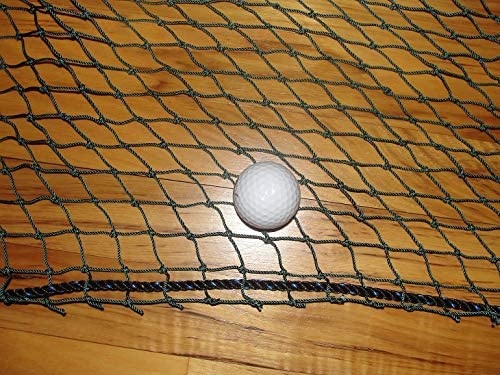Can I Use Batting Cage for Golf?
Dec 5th 2023
Can I Use Batting Cage for Golf?
You probably came to our page, wondering, can a batting cage be used as a golf cage?
Mainly used by baseball and softball players, a batting cage is an enclosed practice area. It is usually rectangular in shape and has netting as its primary component. It also comes with chain-link fence although it is not required.
Structure- and material-wise, you can see why many find batting cages as alternative for golf cages. But would it work the same as how golf hitting cage does?
In this article, we will help you distinguish the difference between a batting cage and a golf cage as well as whether it is feasible to the former as the latter.
Let’s begin.
Can a Batting Cage Be Used as an Alternative for Golf Cage?

Given its structure and material, a batting cage can be an alternative for a golf cage and used as a golf practice area. To effectively used it as one, however, you will need to use a golf netting to replace the batting cage netting.
Here’s why.
Batting cage nets have a mesh size of 1-3/4 inch or 1-7/8 inch, which is huge to stop golf balls from passing through and out of the enclosure. Golf ball netting, on the one hand, has a mesh size of 7/8 inch only, and is perfect for trapping golf balls.
That said, if you have a batting cage at home already, the simplest solution is to create a golf hitting cage that you can clip up inside your batting cage.
The Difference Between Golf Cage and Batting Cage
Batting and golf cages are designed for different purposes, which makes them unique in many ways. Essentially, each type of cage is an adaptation to the needs of the sport it serves, including the safety requirements, space constraints, and the specific skills being practiced.
Here’s how a golf cage differs from a batting cage.
Design
A golf cage and a batting cage varies in terms of design. The former, for instance, is often a smaller and has a more compact netted structure that is wide enough to accommodate the swing of a golf club. It is also essentially designed to safely contain golf balls hit at high speeds inside the enclosure only.
A batting cage, on the other hand, is usually a long and narrow enclosure that can be netted or semi-enclosed with a series of nets to stop baseballs and softballs. It needs to be long enough for the ball to travel and hit the net after being struck and allow pitchers or pitching machines to throw balls to the batter without risk of errant balls causing damage or injury.
Purpose
Purpose-wise, the two cages differ significantly. A golf cage is built and designed for golf players. Hence, it is intended to be used by golfers to practice their swings and work on their drive or other shots.
A batting cage, on the other hand, is designed for baseball or softball players to practice their batting. It allows hitters to work on their swing and timing against pitched balls.
Size
There is a huge difference between a golf cage and a batting cage’s size. Generally, a golf cage is smaller compared to a batting cage. Primarily, it is because golf balls do not need to travel far to be safely contained—unlike in baseball and softball where the ball needs to travel some distance.
A golf cage’s size is typically around 10ft wide and 10ft deep. A batting cage, on the other hand, must be lengthy, usually between 40ft to 70ft in length. For the height and width, the size should be enough for the players to comfortably fit inside the enclosure—the same goes with the pitcher and pitching machine.
Netting
For the netting, both sports need durable net that can safely and effectively contain golf balls and baseballs. For the batting cage, for instance, the net must be strong enough to contain hits from softballs and baseballs. The size of the mesh is often larger than the one in golf cages too.
The netting in golf cages, on the one hand, often has tighter mesh. And mainly it is because of the golf ball’s size, which is smaller compared to baseballs and softballs. Golf balls are often hit at higher speed as well, which ultimately requires finer mesh to contain them.
Golf Netting vs. Batting Netting
**
Mesh Size
As faintly discussed above, a golf cage and a batting cage’s netting slightly differs in several aspects. A golf cage netting, for example, has smaller mesh size compared to a batting cage netting. Mainly it is because the golf balls are smaller in size and need a mesh that is close-knit enough to contain them effectively and safely—typically an inch across.
A batting cage netting, however, has mesh that is larger in size compared to golf cage netting. Primarily, the reason is the same as the with golf cage netting—the size of the ball. The size is about 2.9 inches and 3.8 inches in diameter, respectively.
Material
In terms of material, both netting must be made from an extremely durable material that can effectively contain both type of balls. Generally, both nettings are made from nylon.
To be specific, golf cage and batting cage netting uses #36 nylon twine.
Number 36 nylon twine is a type of nylon string that is commonly used for making batting cage nets, golf hitting cages, and other sports equipment. It is made of 100% nylon fiber, which provides excellent resistance to abrasion, oil, and most chemicals 1.
The #36 refers to the thickness of the twine. The higher the number, the thicker the twine. For example, #21 twine is thinner than #36 twine 2.
A golf cage netting, however, is often made from a strong type of nylon with high abrasion resistance. It can also be made from polyester. And it is because golf balls are hit at an extremely high speed and significant force.
What Is the Difference between Nylon and Polyester Netting?
The primary difference between nylon and polyester netting is the material used to make them. Nylon is a synthetic polymer made from petroleum, while polyester is a synthetic polymer made from coal, air, water, and petroleum products.
In terms of their properties, both materials offer similar benefits.
However, they do have some distinct differences. Polyester is more durable than nylon and has a higher melting point, while nylon typically offers increased elasticity and moisture absorption.
Support Structure
The support structure for both sports are quietly different. A golf netting, for example, may be hung on a simple frame if it is just for personal use—or a more complex structure at driving ranges where it may need to cover a larger area and protect surroundings.
Batting cages require a sturdy frame that often includes overhead netting to contain balls within the hitting area.
Installing a Golf Hitting Cage Inside a Batting Cage
To create a golf hitting cage inside a batting cage, you can follow these steps:
Step1: First, you need to purchase a golf netting that has a mesh size of 7/8 inch, which is perfect for trapping golf balls.
Step2: Next, you need to create a golf hitting cage that you can clip up inside your batting cage. You can use our net calculator to create a golf hitting cage that fits your batting cage dimensions. The golf hitting cage should be made of #36 nylon twine and have a black color to avoid distracting baseball or softball hitters.
Step3: Once you have the golf hitting cage, you can clip it up inside your batting cage using snap hooks or zip ties.
Alternatively, you can build an entire batting cage tunnel out of golf mesh, but it can be prohibitively expensive in many cases because the mesh size for golf is significantly smaller than that of batting cage nets.
How to Find the Right size for a golf Hitting Cage?
The standard size for a golf hitting cage is around 10 feet wide, 10 feet long, and 10 feet tall. However, you can adjust the dimensions according to your available space.
If you are interested in building your own golf hitting cage, you can follow these steps:
Step1: Determine how large you want your golf cage to be based on your available space.
Step2: Cut PVC pipes to length using a PVC pipe cutter.
Step3: Assemble the frame using PVC connectors.
Step4: Attach the golf netting to the frame using zip ties or snap hooks.
Conclusion
If you have spare batting cage and planning to turn it into a golf cage, now is the time to do that! Given that both has the same structure and material, you can indeed use the latter as an alternative for the former.
Whether the aim is casual entertainment, dedicated practice, or professional training, Spectrum Golf hopes that we have provided you the right information to guide you in creating well-built golf simulator system.
Spectrum Golf aims to provide all the equipment one needs to build the best golf simulator setup. We offer FREE design services and can provide a complete layout of your golf simulator too.
Visit our shop now and make sure to check it out!



